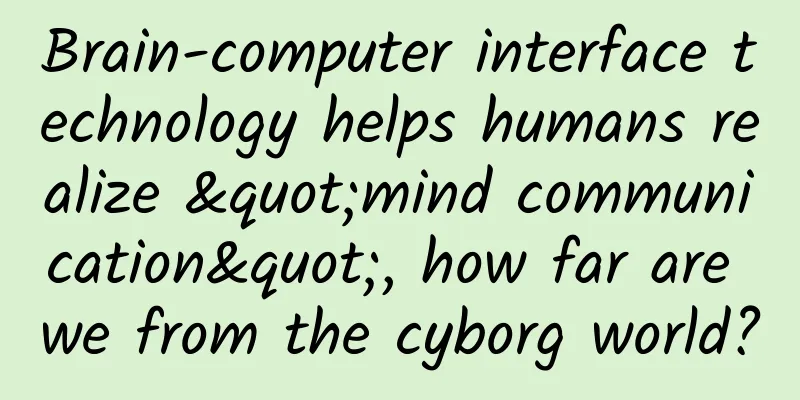Brain-computer interface technology helps humans realize "mind communication", how far are we from the cyborg world?

|
After a stroke, brain damage leads to limb paralysis and language dysfunction, which seriously affects the patient's quality of life and communication ability. In order to help stroke patients restore their language function, the medical community has been working hard to overcome this problem. In the past, some patients with language dysfunction could communicate with the outside world by typing on the keyboard, but this required them to be able to control part of their limbs, and the typing speed was still too slow, and the communication was not smooth enough. Brain-computer interface technology and artificial intelligence technology have shown great potential in solving this difficult problem, and new research results continue to emerge. Brain-computer interface enables “talking with thoughts” Recently, a team led by Yulia Berezutskaya from the Donders Institute for Brain, Cognition and Behavior at Radboud University in the Netherlands and the University Medical Center Utrecht in the Netherlands published a research report in the journal Neuroengineering, saying that they temporarily implanted a brain-computer interface in some non-paralyzed volunteers. These volunteers were asked to speak out loud 12 given words, and the device recorded their brain activity signals. Image source: pixabay Author: CDD20 Subsequently, the researchers used advanced artificial intelligence to decode the volunteers' brain activity signals, establish a one-to-one correspondence between them and specific words, and convert the signals into speech output. The experiment was successful on these volunteers, and the results showed that this not only accurately identified the words corresponding to the brain activity signals, with an accuracy rate of 92% to 100%, but even more amazingly, the machine-converted speech was very close to the volunteers themselves in intonation and accent. This means that speaking through thoughts will become possible! Image source: piqsels Perhaps one day, people with speech disorders will only need to think about what they want to say in their heads, and the brain-computer interface will be able to capture brain activity signals and instantly output them as complete and fluent sentences through the machine. When ordinary people communicate with them, it will be as smooth as communicating with real people. Yulia believes that the model they have built so far has achieved certain results by using only a relatively small data set to better reveal the complex mapping relationship between brain activity and speech. However, they also pointed out that this model has limitations. Currently, they have only conducted experiments on volunteers who are not paralyzed and have only tested 12 words. Therefore, the scope of application of this model may still be very limited. To achieve the understanding of any word, complete sentence or even paragraph, a larger data set, more advanced brain-computer interface implants and more powerful artificial intelligence language model research and breakthroughs are needed. Opportunities and Challenges of Brain-Computer Interfaces Although there is still a long way to go, Yulia believes that they are moving in the right direction. She said that the ultimate goal of this technology is to enable paralyzed patients who have lost both muscle control and language ability and are completely unable to communicate with the outside world to convert what they want to say into voice output through a brain-computer interface and regain the ability to communicate. Image source: pixabay Author: geralt Technologies such as brain-computer interfaces, big data, and artificial intelligence provide new options for patients with brain diseases such as stroke to restore their ability to communicate. With further development of technology, we believe that they will be able to accurately decode any brain activity in the future, allowing more patients who have lost their language ability to regain the ability to communicate through voice, greatly improving their quality of life, and benefiting more ordinary people. At the same time, we also see that these technologies still have many unresolved problems, such as brain implants may cause intracranial infections, and big data and artificial intelligence technologies involve risks to citizens' privacy and information security. We hope that these problems can also be properly resolved in the future. References [1] https://www.hackster.io/news/brain-implants-and-artificial-intelligence-turn-thoughts-into-intelligible-speech-researchers-prove-96af60962d62 [2] http://news.eeworld.com.cn/medical_electronics/ic650064.html [3] Julia Berezutskaya et al 2023 J. Neural Eng. 20 056010 Planning and production Source: "Voice of Science and Technology Association" WeChat public account Author: Zeng Xinyue, a popular science writer Editor: Jin Yufen |
<<: The strange structure of the elephant's body can actually prevent cancer? | Nature Trumpet
>>: Mianyang, Sichuan, don’t be so low-key!
Recommend
The oldest European spruce in the world is called... Husky
There are several Linnaeus Trails in Uppsala, Swe...
A well-known male star revealed that he had cancer and became a hot topic! The incidence of this cancer continues to rise, pay attention to 4 points and try to stay away from it!
Recently, 36-year-old Korean actor Jang Keun Suk ...
Google is fixing an issue with Android's WebView component causing app crashes
[[389179]] Recently, many users have complained o...
To those who spray disinfectant at others, I advise you to be kind!
I once heard a saying You procrastinate because y...
What is on the list of lockdown areas in Pudong, Shanghai in 2022? When will the blockade be lifted? Attached are the latest regulations!
Based on preliminary screening results and risk a...
The Yellow River is not "yellow" anymore! Can it still be called the "Yellow River" after it becomes clear?
Is the Yellow River going to be renamed? This riv...
Gong Peiyuan, Vice President and Executive Partner of Gartner: Analyzing the five key areas of "new infrastructure"
Source: Communication World, author: Liu Tingyi R...
Dongfeng is not in debt. Has the window of opportunity for OLED TV explosion arrived?
It is said in "The Art of War" that &qu...
Are you overwhelmed by the choices when buying things for your children? Are you worried about safety? Parents must read this new regulation!
Children's cosmetics with heavy metal residue...
When your ears and eyes send out these 3 signals, your heart may be "calling for help"!
Some seemingly insignificant physical changes may...
Query the price of joining Zhangbei Luggage Mini Program. How much is the price of joining Zhangbei Luggage Mini Program?
For entrepreneurs, although mini program developm...
It costs tens of thousands of yuan to "start up" the machine once. What are the advantages of surgical robots?
Review expert: Shi Yunlei, PhD, Department of Inf...
NetEase's secret to creating popular content!
How did NetEase achieve tens of millions of scree...
Tips for live streaming on video accounts!
In March, I participated in the video account cha...
Recommended tea drinking and tasting studios worth trying in Chengdu in 2022. Private contact information to lead the way
Contact for Chengdu Tea Tasting Studio: [181.8091...









